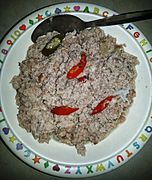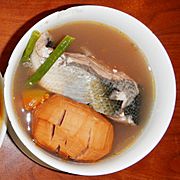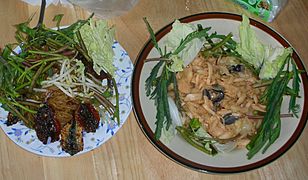Santol facts for kids
Quick facts for kids Santol |
|
|---|---|
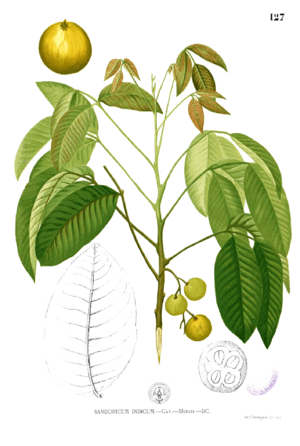 |
|
| Illustration of a santol, from Flora de Filipinas (1877-1883) by Francisco Manuel Blanco | |
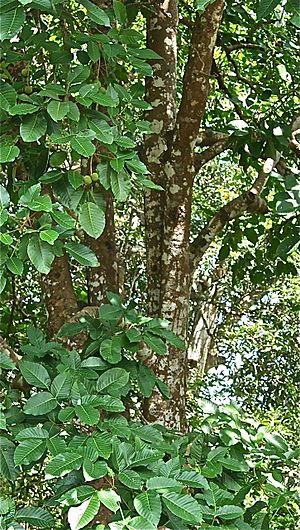 |
|
| Foliage of a mature santol tree in the Philippines | |
| Conservation status | |
| Scientific classification | |
| Genus: |
Sandoricum
|
| Species: |
koetjape
|
 |
|
| Native range of santol in Malesia | |
| Synonyms | |
|
|
The santol (also called sentul or cotton fruit) is a yummy tropical fruit. Its scientific name is Sandoricum koetjape. It comes from Southeast Asia, a warm region near the sea.
Contents
Where Santol Comes From
The santol tree first grew in a region called Malesia. People later brought it to other warm places. These include Indochina, Sri Lanka, India, northern Australia, Mauritius, and Seychelles.
Today, santol trees are grown in many of these areas. You can find their fruits in local and international markets when they are in season.
What Does a Santol Look Like?
Santol fruits come in two main types: yellow and red. The difference is in the color of their older leaves before they fall off. The red type is more common. Its reddish leaves mixed with green ones make the tree look very pretty.
The fruits are often the size and shape of a peach. They can have a slightly fuzzy feel and a reddish tint. Both types have a skin that can be thin or thick, depending on the variety. This skin is often safe to eat. Some kinds of santol have a milky juice inside the skin.
The part of the fruit near the seeds can be sweet or sour. It holds brown seeds that you should not eat. In some santol types, the outer skin is thick. This thick part is the main edible part. It tastes a bit like a peach mixed with an apple. Other types have a thinner, harder skin. For these, you eat the whitish pulp around the seeds. This pulp can be quite sour in many types.
Newer types of santol have a thicker outer skin that is easy to eat with a spoon. This makes them more popular around the world.
The Santol Tree
The santol fruit grows on a tree that grows very fast. It can reach up to 150 feet (about 45 meters) tall! The tree has ribbed leaves. Its flowers are pink or yellow-green and about 1 centimeter long.
How People Use Santol
When santol fruits are ripe, people pick them by hand or use a long stick. The soft inside of the fruit can be eaten raw. Sometimes, people add spices to it. Santol is also cooked and made into candied treats or marmalade.
Santol in Cooking
- In the Philippines, people grate the santol skin. They cook it in coconut milk with pork and hot pepper. This dish is called sinantolan.
- Sour santol fruits are also used in Filipino dishes like sinigang. They add a sour taste to broths.
- In Thailand, santol is used to make som tam when it's not fully ripe.
- It's also a main ingredient in Thai curries, like santol and pork curry or santol and prawn curry.
-
Sinantolan from the Philippines
Other Uses of the Santol Tree
The wood from the santol tree is good for building. It's easy to work with and polish. The tree also makes a great shade tree.
People have used the leaves and bark for medicine. They made a poultice (a soft, moist mass) from them. Some parts of the plant may help with swelling. Some chemicals from santol stems have even shown properties that fight cancer in lab tests. Extracts from santol seeds can also help control insects.
Important Safety Tip About Santol Seeds
Doctors in Thailand and the Philippines have shared warnings about swallowing whole santol seeds. These seeds can sometimes cause problems in the intestines. If you eat santol, always remember to spit out the seeds. If you accidentally swallow a seed and feel a lot of stomach pain, it's important to tell an adult right away.
Growing Santol Trees
Santol trees grow best in warm, humid places. They like rich soil and rain throughout the year, but they can also handle dry periods.
Farmers usually plant santol trees about 20 to 25 feet (6 to 7.5 meters) apart. The trees need fertilizer twice a year to grow well. Trees grown from seeds usually start making fruit after 5 to 7 years. Some special types can produce fruit in just 3 or 4 years.
A grown santol tree can produce a lot of fruit! It can make between 18,000 and 24,000 fruits each year. In places like Puerto Rico, the fruits are ready to pick in August and September.
See also
 In Spanish: Sandoricum koetjape para niños
In Spanish: Sandoricum koetjape para niños




